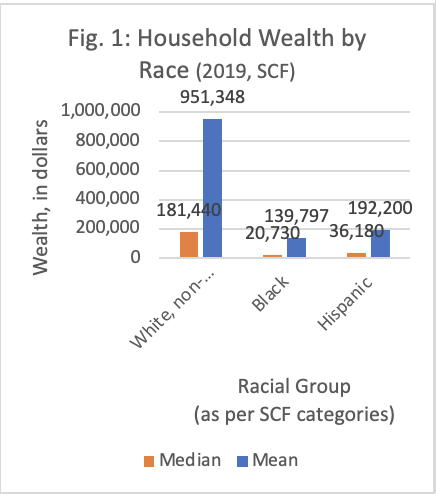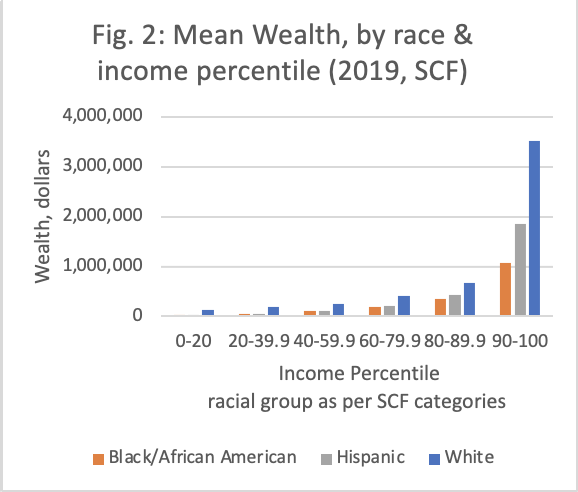

This article is part of our weekly series—The Promise of Targeted Universalism: Community Leaders Respond—that NPQ is publishing in partnership with the national racial and economic justice nonprofit Prosperity Now. In this series, writers examine how targeted universalism—a narrative framework that advocates the use of targeted approaches to achieve universal goals—can inform efforts to close the racial wealth gap, community by community.
The persistent and stubborn racial wealth gap in the United States is well documented. This gap is rooted in the enslavement of Black Americans and structurally reinforced through policy and practices that persist today in the nation’s banking, taxation, housing, transportation, and education systems, to name but a few.
While there is widespread agreement on this condition, there is less agreement on what should be done—and if something is done, there is debate about which group(s) should be the focus. I will not engage these issues directly; some of them will be addressed in other articles in this series. Instead, I propose an alternative way to understand this problem and a way to address it and talk about it.
There is an understandable call for equity when facing the racial wealth gap. And in making this call, the implicit or explicit focus is often to address the gap between white wealth and Black wealth. This makes intuitive sense—but there are some serious limitations in such a singular focus. And these limitations also are present when focusing on eliminating or narrowing racial disparities in other important social markers. A targeted universalism (TU) approach, I believe, addresses many of these limitations. Here I discuss the advantages of TU in the context of the racial wealth gap. Before doing so, it is important to be explicit about the limitation of equity.
The concept and practice of equity has gained momentum in recent decades. Before the turn to engaging with equity in the 1990s, the discussion of racial justice and fairness was primarily envisioned as a call for equality. Equality means that people are treated equally, which is not as simple as it sounds. For instance, for years people debated whether equality meant equal outcomes or equal opportunity. From these debates, the concept of equity was developed to recognize that treating people with unequal starting conditions equally does little to reduce inequality.
Indeed, as an engagement with equity became more pronounced, the shortcomings of simply treating people who faced vastly different circumstances equally became ever more obvious. For example, in the housing system, it was pointed out that fair housing could not be achieved if Black Americans were treated the same as white Americans. This position was buttressed by the disability rights movement.
Limitations of the Equity Approach
Compared to the frame of equality, equity represented an advance in that it recognized the need to respond to situatedness. For example, to address inequality in key areas of the economy like housing or employment requires recognizing that different groups have different relationships with those systems and structures.
A shortfall of the equity approach, however, is that it encourages advocates to focus on what they want to end (disparities), rather than what they want to achieve (universal thriving). When advocates focus on closing disparities, that requires identifying—and defining—a group that is doing better, and very often this group is composed of white people. This measure of this group’s status is then the measurement that other groups are compared to and the outcome set as the aspiration. In the identification of a gap, there is a better performing group—a more favored group—and a single less favored or marginal group. In the context of the racial wealth gap, the less-favored marginalized group is often African Americans. In discussions of the wage gap, the favored group might be men and the less favored group women. In the context of education, often white boys are more favored than Black boys.
While discussions may acknowledge additional disparities—recognizing the gaps between additional groups and the most favored groups—the approach directs our gaze to a binary. The details of how groups are situated recedes and the disparity itself is foregrounded. There is much more I could add, but this may be enough to point out some of the weaknesses to this approach. The favored group becomes the benchmark and desired outcome for all groups. There is not a deep inquiry of how this group is situated or what exactly it is that it possesses, nor is there a deep inquiry into the ways different people within that group are situated. The goal for the less favored group is entirely defined by what the favored group has.
What if the favored group—or different subgroups within it—are seriously lacking what is needed to flourish? Orienting a strategy to “close the gap” renders the power of defining universal targets to members of the favored group. This is problematic because the group at the top of the disparity may lack important resources. This can render invisible any attention to the needs within the apparently favored group. This also limits the aspirations for the scale of change that we seek. Transformational structural change is required, and the ambition should expand beyond tying success to what current outcomes look like.
Finally—and connected to these problems—is that focusing attention and resources on less favored groups may create or deepen a perception of competition between groups. This is likely to increase polarization and breaking—and reduce the needed power to promote transformational reform.
Sign up for our free newsletters
Subscribe to NPQ's newsletters to have our top stories delivered directly to your inbox.
By signing up, you agree to our privacy policy and terms of use, and to receive messages from NPQ and our partners.
The Targeted Universalism Approach
Let’s turn to the ways that targeted universalism addresses these issues. First, TU is anchored by naming a universal goal. In the context of wealth, the goal may be articulated by considering what an individual and community needs to be secure and thrive. This is how the goal is a universal one—it is a goal statement in which many groups see improved futures. It is worth noting that this is a significant distinction from a disparities-based framework, because it is so often assumed that the favored group is secure and thriving. This is not assumed within a TU framework. It might be that some group is close to the universal goal. But in many instances, all will fall short.
Second, TU centers its attention on the situatedness of groups—the gap from the universal goal will vary from group to group. Some groups are more distant from that goal, have different paths to the goal, and have experiences in trying to navigate there. The situatedness of groups are centered in TU by its requirement of articulating different paths groups might pursue to achieve that universal goal; the structural analysis it encourages helps identify these.
Third, dependent upon a thorough analysis, strategies need to be designed that target structural changes that support groups’ reach and paths to the universal goal. These strategies must be targeted to address the situatedness of each group—to navigate around or remove structural barriers, but more importantly to squarely focus on creating new structures that leave in place durable paths to goals.
It is in this way that TU is strictly concerned with outcomes and is proactive. It directs focus to the systemic and structural roots of what are unfair outcomes for different individuals. This approach also turns away from an individual accounting of unfair outcomes. This is in part because those structural processes are incorporated into the change strategies and programs that are developed.
TU is an operational approach that creates new narratives and requires different language to discuss the systemic and structural changes it seeks. Its universal component calls attention to the need to improve circumstances for most, if not all, groups. Its targeted component—the structural analysis of the situatedness of different groups trying to reach the goal—forces analytical attention to be paid to the unique positions and experiences of different groups trying to reach the goal.
Consider TU as applied to the racial wealth gap. First, what is the universal goal? The process of identifying the universal must be iterative and co-created. Different groups participate in helping to identify the universal. One might imagine that the goal is not simply for Black Americans and others to have the same wealth as whites but to also make sure that all people and all groups have what is necessarily to be secure and flourish. Another related goal might be to limit the concentration of wealth so that it does not distort our democracy or our individual and collective belonging. This means inspecting the status of white elites hoarding wealth within the more favored white groups—and this affirms that race and class in the US must be considered in combination with each other and cannot be thought of as binary categories.
Indeed, we know that throughout history, in the US, race and class have been entangled and are inextricably linked to each other. Failure to combine and enrich this structural analysis could mean that we have addressed or are working to address one problem and ignore another—or even worsen the problem.
Often, discussion of the racial wealth gap centers on the median wealth of racial groups. Even if this measure of the racial wealth gap is closed—if median wealth for all groups equaled what white households have—the mean wealth gap would persist. Data from the Survey of Consumer Finances (SCF) of the Federal Reserve, offered below, show us why:


The driver of racial wealth gaps is primarily the wealth held by the wealthiest 10 percent within white and other racial groups. This can easily be seen in figures 1 and 2 above. For example, it is clear from Figure 2 that the top 10 percent of Black American households have more wealth than the bottom 90 percent of white households. Figure 1 shows that even if you added $181,440 (white median wealth) to every Black or Latinx family, that would not eliminate the wealth gap with white elites.
Saying that a goal should be to close a racial wealth gap does not imply an engagement with the persistent hoarding of wealth by elites. Focus on the dominant measurements of the racial wealth gap inadvertently places low wealth white households on the same side of a disparity as their elite counterparts. When a set of policies and strategies are said to close a gap, the implication is that only non-white groups benefit. This focus on closing the gap is likely to create more fracture between groups. This is despite the shared gains they would all have from some policies that could build the wealth necessary for household and community stability and health. These needs—ultimately for a sense of health of communities and individuals—is what centers TU.
TU helps reconcile what otherwise may seem to be contradictory tenets, as it combines a focus on collectively held universal needs and aspirations, alongside a deep appreciation of the vast range of needs within a group. The framework and path of analysis and communication it lays out for us is powerful. It can help realize human flourishing and planetary health—the traces of what belonging would look like. It accomplishes this ambitious and collective project by attending to the needs of non-elites—a diverse group, including some people within the favored wealth group, but who are also alienated by the structural dynamics of elite wealth.
Using TU’s laser focus on structural historic analysis and the modern structural features of wealth accumulation and uneven distribution can improve everyone’s prospects. Only by addressing the structural and systemic facts of life inherited by and through extreme racialized violence can we usher in a world in which everyone truly belongs.













